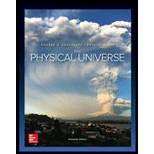
The scientific method is
- a. continuing process
- b. way to arrive at ultimate truth
- c. a laboratory technique
- d. based on accepted laws and theories
To define: The scientific method.
Answer to Problem 1MC
Option (a) a continuing process.
Explanation of Solution
Scientific method is most powerful lens used to unearth and explore the natural world. It is a pattern for obtaining the reliable information about the universe. It is a process involves an iterative process in order to check the information obtained and to confirm obtained information.
Conclusion:
Scientific method is not a onetime process, a laboratory technique or just a process that considers only on accepted laws and theories, rather it is a continuous process to obtain the reliable information about the universe in a systematic organized manner. Thus, option (a) is correct.
Scientific method is a process involves an iterative process in order to check the information obtained and to confirm obtained information. Thus, option (b) is incorrect.
Scientific method is not a laboratory technique or just a process that considers only on accepted laws and theories, rather it is a continuous process to obtain the reliable information about the universe in a systematic organized manner. Thus, option (c) is incorrect.
Scientific method is a process to understand and explore new realms in nature. It is not simply based on accepted laws and theories. Thus, option (d) is incorrect.
Want to see more full solutions like this?
Chapter 1 Solutions
Physical Universe
- Why is it difficult for scientists to replace an old paradigm with a new paradigm?arrow_forwardWhat is the difference between a hypothesis , theory, and a law?arrow_forwardThe price of gasoline at a particular station is 1.5 euros per liter. An American student can use 33 euros to buy gasoline. Knowing that 4 quarts make a gallon and that 1 liter is close to 1 quart, she quickly reasons that she can buy how many gallons of gasoline? (a) less than 1 gallon (b) about 5 gallons (c) about 8 gallons (d) more than 10 gallonsarrow_forward
- 1. Find the answer a. Give evidence that the answer is right b. explain the evidencearrow_forwardTo test a hypothesis you would Select one: a. set up one experiment and see results. b. use results of one experiment to predict. c. find and report the best results. d. set up many experiments and see results.arrow_forwardCentral phenomenon is an issue or a process that the researcher would like to study only. a. FALSE b. TRUEarrow_forward
- It is one of the steps in the scientific methods that MEASURE a variable in an experiment. A. Statement of the problems or objectives B. Formulation of Null Hypothesis C. Observation of the control and experiment variables D. Interpretation of the given dataarrow_forward1. Put each of the following numbers into scientific notation. a. 0.00000584 # of s. d? b. 245 000 000 # of s. d? c. 0.0000705 # of s. d?arrow_forwardTrue or false 1. The unit-factor method is used as a validity tool in deriving equations. 2. Kinetic energy is dependent on the mass and velocity of an object. 3. Acceleration is speed with direction. 4. Physical change in matter alters its appearance and identity. 5. Height is the greatest measurement of a 3D object. 6. The acceleration of an object is dependent on the net force acting on an object. 7. The English system of measurement is based on the power of ten. 8. All objects fall at the same time. 9. Temperature is the flow of energy from a hot area to a cold area. 10. The position of the object increases potential energy.arrow_forward
- 2. Classify the following statements as either True or False : c) Races of different students in a class is quantitative data. True Falsearrow_forwardMatch the following 1. Precision a. the rightmost digit in a recorded data 2. Significant figure b. a combination of two or more direct measurements 3. Accuracy c. fundamental quantity 4. Length d. contain both the certain and uncertain readings 5. Volume e. the left-most digit in a recorded data f. the smallest division on a devicearrow_forwardTrue or false 1. The unit-factor method is used as a validity tool in deriving equations. 2. Kinetic energy is dependent on the mass and velocity of an object. 3. Acceleration is speed with direction. 4. Physical change in matter alters its appearance and identity. 5. Height is the greatest measurement of a 3D object.arrow_forward
 Physics for Scientists and Engineers, Technology ...PhysicsISBN:9781305116399Author:Raymond A. Serway, John W. JewettPublisher:Cengage Learning
Physics for Scientists and Engineers, Technology ...PhysicsISBN:9781305116399Author:Raymond A. Serway, John W. JewettPublisher:Cengage Learning Glencoe Physics: Principles and Problems, Student...PhysicsISBN:9780078807213Author:Paul W. ZitzewitzPublisher:Glencoe/McGraw-Hill
Glencoe Physics: Principles and Problems, Student...PhysicsISBN:9780078807213Author:Paul W. ZitzewitzPublisher:Glencoe/McGraw-Hill College PhysicsPhysicsISBN:9781285737027Author:Raymond A. Serway, Chris VuillePublisher:Cengage Learning
College PhysicsPhysicsISBN:9781285737027Author:Raymond A. Serway, Chris VuillePublisher:Cengage Learning Horizons: Exploring the Universe (MindTap Course ...PhysicsISBN:9781305960961Author:Michael A. Seeds, Dana BackmanPublisher:Cengage Learning
Horizons: Exploring the Universe (MindTap Course ...PhysicsISBN:9781305960961Author:Michael A. Seeds, Dana BackmanPublisher:Cengage Learning An Introduction to Physical SciencePhysicsISBN:9781305079137Author:James Shipman, Jerry D. Wilson, Charles A. Higgins, Omar TorresPublisher:Cengage Learning
An Introduction to Physical SciencePhysicsISBN:9781305079137Author:James Shipman, Jerry D. Wilson, Charles A. Higgins, Omar TorresPublisher:Cengage Learning




